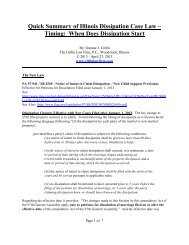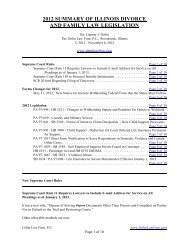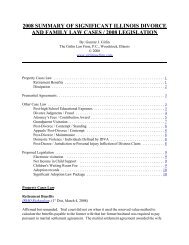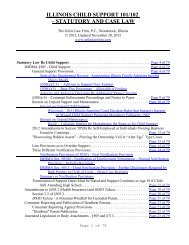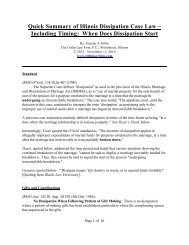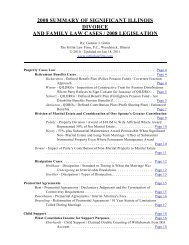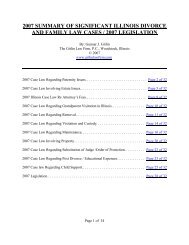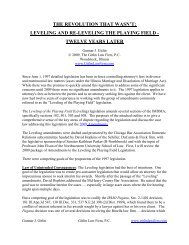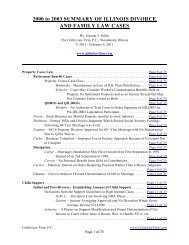child support 101/102 - The Gitlin Law Firm
child support 101/102 - The Gitlin Law Firm
child support 101/102 - The Gitlin Law Firm
Create successful ePaper yourself
Turn your PDF publications into a flip-book with our unique Google optimized e-Paper software.
we eliminated the effect of tax bracketing used in the federal income tax system. We<br />
believe that eliminating this effect is equitable. Neither party should benefit or be<br />
prejudiced by the artifice of considering certain income as falling into a certain<br />
bracket. Moreover, in determining appropriate <strong>child</strong> <strong>support</strong>, we are not bound by the<br />
technicalities of federal income tax law. See In re Marriage of McGowan, 265 Ill.<br />
App. 3d 976, 979 (1994).”<br />
This decision is a well-reasoned and complex decision. It points to the complex nature of proper<br />
<strong>support</strong> calculations. <strong>The</strong> appellate court did not base the taxes on the highest marginal tax bracket<br />
or on the lowest marginal tax bracket. Instead, it determined the overall effective tax bracket and<br />
determined taxes on this basis. For a further discussion of this topic, see the outlines regarding tax<br />
calculations in <strong>support</strong> cases.<br />
B. Method of Calculating Net Income: Attached is a worksheet for calculation of net<br />
income. This worksheet will let you know what to look for when you analyze net income<br />
calculations offered by either party. Some judges use a tax program in chambers to determine net<br />
income. An excellent program of this type is FinPlan, (800) 777-2108.<br />
1. Gross Income: Determine the gross income.<br />
2. Adjusted Gross Income: Determine the adjusted gross income by<br />
subtracting adjustments from the gross income. <strong>The</strong> common adjustments<br />
are maintenance payments and certain voluntarily retirement contributions.<br />
One key issue is whether you allow maintenance to be an “above the line”<br />
deduction (adjustment) in determining the adjusted gross income. Arguments<br />
can be made on either side of this issue.<br />
3. Itemized or Standard Deductions and Exemptions: From the adjusted<br />
gross income, subtract the exemptions and the deductions. For final hearings,<br />
assume the tax status following the divorce. Thus, if the <strong>child</strong> <strong>support</strong> payor<br />
is awarded a residence and you know the amount of itemized deductions, use<br />
itemized deductions. If itemized deductions are not known, then use the<br />
standard deduction. Use the total number of exemptions that the payor will<br />
be entitled to following the divorce. In post-decree proceedings use the<br />
actual number of exemptions claimed by the payor.<br />
4. Federal Tax Rate: Apply the tax chart to determine the federal tax. See my<br />
attached 2007 Federal tax chart or determine this using a program such as<br />
FinPlan.<br />
Single Taxable Income<br />
Rate<br />
Head Household<br />
Taxable Income<br />
Rate<br />
0-7,825 10% 0-11,200 10%<br />
7,825-31,850 $782.50 + 15% over 11,200-42,650 $1,120 + 15% over 11,200<br />
<strong>Gitlin</strong> <strong>Law</strong> <strong>Firm</strong>, P.C. 1-28 www.gitlinlawfirm.com




